1414 Content of Reissue Oath/Declaration [R-07.2022]
The reissue oath/declaration as required by 37 CFR 1.175 is an essential part of a reissue application and must be filed with the application, or within the time period set under 37 CFR 1.53(f) along with the required surcharge as set forth in 37 CFR 1.16(f) in order to avoid abandonment. The question of the sufficiency of the reissue oath/declaration filed under 37 CFR 1.175 must in each case be reviewed and decided personally by the primary examiner.
Much of the required content of a reissue oath or declaration will differ based on the filing date of the reissue application. However, all reissue oaths or declarations must contain the following:
- (A) A statement that the applicant believes the original patent to be
wholly or partly inoperative or invalid—
- (1) by reason of a defective specification or drawing, or
- (2) by reason of the patentee claiming more or less than patentee had the right to claim in the patent; and
- (B) A statement of at least one error which is relied upon to support the reissue application, i.e., as the basis for the reissue.
Subsections I and II below describe the requirements for each of the aforementioned statements. See MPEP § 1414.01 for the remaining requirements for the reissue oath or declaration in a reissue application filed on or after September 16, 2012; MPEP § 1414.02 for the remaining requirements of a reissue oath or declaration in a reissue application filed before September 16, 2012; and MPEP § 1414.03 for supplemental reissue oaths or declarations in reissue applications filed before September 16, 2012.
I. A STATEMENT THAT THE APPLICANT BELIEVES THE ORIGINAL PATENT TO BE WHOLLY OR PARTLY INOPERATIVE OR INVALID BY REASON OF A DEFECTIVE SPECIFICATION OR DRAWING, OR BY REASON OF THE PATENTEE CLAIMING MORE OR LESS THAN PATENTEE HAD THE RIGHT TO CLAIM IN THE PATENTIn order to satisfy this requirement, a declaration can state for example:
- 1. “Applicant believes the original patent to be partly inoperative or invalid by reason of a defective specification or drawing.”
- 2. “Applicant believes the original patent to be partly inoperative or invalid by reason of the patentee claiming more than patentee had a right to claim in the patent.”
- 3. “Applicant believes the original patent to be partly inoperative or invalid by reason of the patentee claiming less than patentee had a right to claim in the patent.”
It should be noted that the reissue oath/declaration must also satisfy the requirement for a statement of at least one error being relied upon as the basis for reissue, in the manner set forth in subsection II below.
Even though only one error upon which reissue is based needs to be described in the reissue oath/declaration, if PTO/SB/51 or PTO/SB/52 form is used (or PTO/AIA/05 or PTO/AIA/06, for applications filed on or after September 16, 2012), applicant needs to check the appropriate box(es) on the form identifying each of the reasons why the patent is wholly or partly inoperative or invalid. Even if a PTO form is not used, applicant needs to state each of the reasons why the patent is wholly or partly inoperative or invalid in the reissue oath/declaration.
Form paragraph 14.01.05 may be used where the reissue oath/declaration does not provide the required statement as to applicant’s belief that the original patent is wholly or partly inoperative or invalid.
¶ 14.01.05 Defective Reissue Oath/Declaration, 37 CFR 1.175 - No Statement of Defect in the Patent
The reissue oath/declaration filed with this application is defective because it fails to contain the statement(s) required under 37 CFR 1.175 as to applicant’s belief that the original patent is wholly or partly inoperative or invalid. [1]
Examiner Note:
- 1. Use this form paragraph when applicant: (a) fails to allege that the original patent is inoperative or invalid and/or (b) fails to state the reason of a defective specification or drawing, or of patentee claiming more or less than patentee had the right to claim in the patent. In bracket 1, point out the specific defect to applicant by using the language of (a) and/or (b), as it is appropriate.
- 2. Form paragraph 14.14 must follow this form paragraph.
- (A) A reissue applicant must acknowledge the existence of an error in the specification, drawings, or claims, which error causes the original patent to be defective. In re Wilder, 736 F.2d 1516, 222 USPQ 369 (Fed. Cir. 1984). A change or departure from the original specification or claims represents an “error” in the original patent under 35 U.S.C. 251. See MPEP § 1402 for a discussion of grounds for filing a reissue that may constitute the “error” required by 35 U.S.C. 251. Not all changes with respect to the patent constitute the “error” required by 35 U.S.C. 251. It is noted that an error to be corrected under 35 U.S.C. 251 may be the addition of a claim or claims that is/are narrower in scope than the existing patent claims, without any narrowing of the existing patent claims. See In re Tanaka, 640 F.3d 1246, 1251, 98 USPQ2d 1331, 1334 (Fed. Cir. 2011).
- (B) Applicant need only specify in the reissue oath/declaration one
of the errors upon which reissue is based. Where applicant specifies one such
error, this requirement of a reissue oath/declaration is satisfied. Applicant may
specify more than one error and examiners should not object that more than one
error is specified in the reissue oath/declaration.
Where more than one error is specified in the oath/declaration and some of the designated “errors” are found to not be “errors” under 35 U.S.C. 251, any remaining error which is an error under 35 U.S.C. 251 will still support the reissue.
The “at least one error” pursuant to 35 U.S.C. 251 which is relied upon to support the reissue application must be specifically identified in the oath/declaration. It is not necessary, however, to point out how (or when) the error arose or occurred. Further, it is not necessary to point out how (or when) the error was discovered. If an applicant chooses to point out these matters, the statements directed to these matters will not be reviewed by the examiner, and the applicant should be so informed in the next Office action. What is needed for the oath/declaration statement as to error is the identification of “at least one error” relied upon.
For an application filed on or after September 16, 2012 that seeks to enlarge the scope of the claims of the patent, the reissue oath or declaration must also identify a claim that the application seeks to broaden in the identification of the error that is relied upon to support the reissue application. A general statement, e.g., that all claims are broadened, is not sufficient to satisfy this requirement. In specifically identifying the error as required by 37 CFR 1.175(a), it is sufficient that the reissue oath/declaration identify the claim being broadened and a single word, phrase, or expression in the specification or in an original claim, and how it renders the original patent wholly or partly inoperative or invalid. The corresponding corrective action which has been taken to correct the original patent need not be identified in the oath/declaration. If the initial reissue oath/declaration “states at least one error” in the original patent, and, in addition, recites the specific corrective action taken in the reissue application, the oath/declaration would be considered acceptable, even though the corrective action statement is not required.
- (C) It is not sufficient for an
oath/declaration to merely state “this application is being filed to correct
errors in the patent which may be noted from the changes made in the disclosure.”
Rather, the oath/declaration must specifically identify an error. In addition, it
is not sufficient to merely reproduce the claims with brackets and underlining and
state that such will identify the error. Any error in the claims must be
identified by reference to the specific claim(s) and the specific claim language
wherein lies the error.
A statement in the oath/declaration of "…failure to include a claim directed to …" and then reciting all the limitations of a newly added claim, would not be considered a sufficient "error" statement because applicant has not pointed out what the other claims lacked that the newly added claim has, or vice versa. Such a statement would be no better than saying in the reissue oath or declaration that "this application is being filed to correct errors in the patent which may be noted from the change made by adding new claim 10." In both cases, the error has not been identified.
Likewise, a statement of the error as "…the inclusion of claims 3-5 which were unduly broad…" and then canceling claims 3-5, would not be considered a sufficient "error" statement because applicant has not pointed out what the canceled claims lacked that the remaining claims contain. The statement of what the remaining claims contain need not identify specific limitations, but rather may provide a general identification, such as "Claims 3-5 did not provide for any of the tracking mechanisms of claims 6-12, nor did they provide an attachment mechanism such as those in claims 1-2 and 9-16."
- (D) For continuation or divisional reissue
applications:
- (1) Where a continuation reissue application is filed with a copy of the reissue oath/declaration from the parent reissue application, and the parent reissue application is not to be abandoned, the reissue oath/declaration should be accepted by the Office of Patent Application Processing (OPAP) without further evaluation, because it is an oath/declaration, albeit improper under 35 U.S.C. 251. The examiner should, however, reject the claims of the continuation reissue application under 35 U.S.C. 251 as being based on an oath/declaration that does not identify an error being corrected by the continuation reissue application, and should require a new oath/declaration that identifies a new error or a statement explaining compliance with 37 CFR 1.175(f)(2) if appropriate. If the same error corrected in the parent is also being corrected in the continuation reissue application, but the error is being corrected in a different way, a statement is needed to explain compliance with 37 CFR 1.175(f)(2) for a reissue application filed on or after September 16, 2012. For these applications, a petition under 37 CFR 1.183 is not needed. For a reissue application filed before September 16, 2012, a petition under 37 CFR 1.183 will be needed to waive pre-AIA 37 CFR 1.175(e) in order to rely on the same error identified in the parent but being corrected in a different way. See 37 CFR 1.175(f)(2) for reissue applications filed on or after September 16, 2012, and pre-AIA 37 CFR 1.175(e) for reissue applications filed before September 16, 2012. One of form paragraphs 14.01.01, 14.01.02, or 14.01.03 may be used.
- (2) Where a continuation reissue application is filed with a copy of the reissue oath/declaration from the parent reissue application, and the parent reissue application is, or will be abandoned, the copy of the reissue oath/declaration should be accepted by the Office of Patent Application Processing (OPAP), and the examiner should check to ensure that the oath/declaration identifies an error which is still being corrected in the continuation application. For reissue applications filed before September 16, 2012, pursuant to pre-AIA 37 CFR 1.175(b)(1), for any error corrected via the preliminary amendment which is not covered by the oath or declaration submitted in the parent reissue application, applicant must submit a supplemental oath/declaration stating that such error arose without any deceptive intention on the part of the applicant. See MPEP § 1414.03.
- (3) Where a divisional reissue application is filed with a copy of the reissue oath/declaration from the parent reissue application, the reissue oath/declaration should be accepted by OPAP, because it is an oath/declaration, though it may be improper under 35 U.S.C. 251. The examiner should check the copy of the oath/declaration to ensure that it identifies an error being corrected by the divisional reissue application. The copy of the oath/declaration from the parent reissue application may or may not cover an error being corrected by the divisional reissue application because the divisional reissue application is (by definition) directed to a new invention. If the copy of the oath/declaration does not cover an error being corrected by the divisional reissue application, the examiner should reject the claims of the divisional reissue application under 35 U.S.C. 251 as being based on an oath/declaration that does not identify an error being corrected by the divisional reissue application, and require a new oath/declaration. Even where the divisional reissue application was filed on or after September 16, 2012, a new reissue oath/declaration will be required, because the divisional reissue application is a new application, and a new application requires the error to be set forth in the oath/declaration. If the copy of the reissue oath/declaration from the parent reissue application does in fact cover an error being corrected in the divisional reissue application, no such rejection should be made. See MPEP § 1414.01. Form paragraph 14.01.01 may be used where the reissue oath/declaration does not identify an error.
¶ 14.01.01 Defective Reissue Oath/Declaration, 37 CFR 1.175 - No Statement of a Specific Error
The reissue oath/declaration filed with this application is defective because it fails to identify at least one error which is relied upon to support the reissue application. See 37 CFR 1.175 and MPEP § 1414.
Examiner Note:
- 1. Use this form paragraph when the reissue oath or declaration does not contain any statement of an error which is relied upon to support the reissue application.
- 2. This form paragraph can be used where the reissue oath or declaration does not even mention error. It can also be used where the reissue oath or declaration contains some discussion of the concept of error but never in fact identifies a specific error to be relied upon. For example, it is not sufficient for an oath or declaration to merely state “this application is being filed to correct errors in the patent which may be noted from the changes made in the disclosure.”
- 3. Form paragraph 14.14 must follow this form paragraph.
Where the reissue oath/declaration does identify an error or errors, the oath/declaration must be checked carefully to ensure that at least one of the errors identified is indeed an “error” which will support the filing of a reissue, i.e., an “error” that will provide grounds for reissue of the patent. See MPEP § 1402. If the error identified in the oath/declaration is not an appropriate error upon which a reissue can be based, then the oath/declaration must be indicated to be defective in the examiner’s Office action.
Form paragraphs 14.01.02 and 14.01.03 may be used where the reissue oath/declaration fails to provide at least one error upon which a reissue can be based.
¶ 14.01.02 Defective Reissue Oath/Declaration, 37 CFR 1.175 - The Identified “Error” Is Not Appropriate Error
The reissue oath/declaration filed with this application is defective because the error which is relied upon to support the reissue application is not an error upon which a reissue can be based. See 37 CFR 1.175 and MPEP § 1414.
Examiner Note:
- 1. Use this form paragraph when the reissue oath/declaration identifies only one error which is relied upon to support the reissue application, and that one error is not an appropriate error upon which a reissue can be based.
- 2. Form paragraph 14.14 must follow this form paragraph.
¶ 14.01.03 Defective Reissue Oath/Declaration, 37 CFR 1.175 - Multiple Identified “Errors” Not Appropriate Errors
The reissue oath/declaration filed with this application is defective because none of the errors which are relied upon to support the reissue application are errors upon which a reissue can be based. See 37 CFR 1.175 and MPEP § 1414.
Examiner Note:
- 1. Use this form paragraph when the reissue oath/declaration identifies more than one error relied upon to support the reissue application, and none of the errors are appropriate errors upon which a reissue can be based.
- 2. Note that if the reissue oath/declaration identifies more than one error relied upon, and at least one of the errors is an error upon which reissue can be based, this form paragraph should not be used, despite the additional reliance by applicant on “errors” which do not support the reissue. Only one appropriate error is needed to support a reissue.
- 3. Form paragraph 14.14 must follow this form paragraph.
¶ 14.01.06 Defective Reissue Oath/Declaration, 37 CFR 1.175 - General
The reissue oath/declaration filed with this application is defective (see 37 CFR 1.175 and MPEP § 1414) because of the following:
Examiner Note:
- 1. Use this form paragraph when the reissue oath/declaration does not comply with 37 CFR 1.175, and none of form paragraphs 14.01.01 - 14.01.05 or 14.05.02.fti apply.
- 2. This form paragraph must be followed by an explanation of why the reissue oath/declaration is defective.
- 3. Form paragraph 14.14 must follow the explanation of the defect.
¶ 14.14 Rejection, Defective Reissue Oath or Declaration
Claim [1] rejected as being based upon a defective reissue [2] under 35 U.S.C. 251 as set forth above. See 37 CFR 1.175.
The nature of the defect(s) in the [3] is set forth in the discussion above in this Office action.
Examiner Note:
- 1. In bracket 1, list all claims in the reissue application. See MPEP § 1444, subsection II.
- 2. This paragraph must be preceded by form paragraph 14.01 and should be preceded by form paragraphs 14.01.01 to 14.01.06 as appropriate
- 3. In brackets 2 and 3, insert either --oath-- or --declaration--.
1414.01 Reissue Oath or Declaration in Reissue Application Filed On or After September 16, 2012 [R-01.2024]
[Editor Note: See MPEP § 1414.02 for reissue applications filed before September 16, 2012.]
37 CFR 1.175 Inventor's oath or declaration for a reissue application.
- (a) The inventor’s oath or declaration for a reissue application, in addition to complying with the requirements of § 1.63, § 1.64, or § 1.67, must also specifically identify at least one error pursuant to 35 U.S.C. 251 being relied upon as the basis for reissue and state that the applicant believes the original patent to be wholly or partly inoperative or invalid by reason of a defective specification or drawing, or by reason of the patentee claiming more or less than the patentee had the right to claim in the patent.
- (b) If the reissue application seeks to enlarge the scope of the claims of the patent (a basis for the reissue is the patentee claiming less than the patentee had the right to claim in the patent), the inventor’s oath or declaration for a reissue application must identify a claim that the application seeks to broaden. A claim is a broadened claim if the claim is broadened in any respect.
- (c) The inventor, or each individual who is a joint
inventor of a claimed invention, in a reissue application must execute an oath
or declaration for the reissue application, except as provided for in
§
1.64, and except that the inventor’s oath or declaration
for a reissue application may be signed by the assignee of the entire interest
if:
- (1) The application does not seek to enlarge the scope of the claims of the original patent; or
- (2) The application for the original patent was filed under § 1.46 by the assignee of the entire interest.
- (d) If errors previously identified in the inventor’s oath or declaration for a reissue application pursuant to paragraph (a) of this section are no longer being relied upon as the basis for reissue, the applicant must identify an error being relied upon as the basis for reissue.
- (e) The inventor’s oath or declaration for a reissue application required by paragraph (a) of this section may be submitted under the provisions of § 1.53(f), except that the provisions of § 1.53(f)(3) do not apply to a reissue application.
- (f)
- (1) The requirement for the inventor’s oath or
declaration for a continuing reissue application that claims the benefit
under 35 U.S.C. 120,
121, 365(c), or
386(c) in compliance
with § 1.78 of an
earlier-filed reissue application may be satisfied by a copy of the
inventor’s oath or declaration from the earlier-filed reissue
application, provided that:
- (i) The inventor, or each individual who is a joint inventor of a claimed invention, in the reissue application executed an inventor’s oath or declaration for the earlier-filed reissue application, except as provided for in § 1.64;
- (ii) The continuing reissue application does not seek to enlarge the scope of the claims of the original patent; or
- (iii) The application for the original patent was filed under § 1.46 by the assignee of the entire interest.
- (2) If all errors identified in the inventor’s oath or declaration from the earlier-filed reissue application are no longer being relied upon as the basis for reissue, the applicant must identify an error being relied upon as the basis for reissue.
- (1) The requirement for the inventor’s oath or
declaration for a continuing reissue application that claims the benefit
under 35 U.S.C. 120,
121, 365(c), or
386(c) in compliance
with § 1.78 of an
earlier-filed reissue application may be satisfied by a copy of the
inventor’s oath or declaration from the earlier-filed reissue
application, provided that:
- (g) An oath or declaration filed at any time pursuant to 35 U.S.C. 115(h)(1), will be placed in the file record of the reissue application, but may not necessarily be reviewed by the Office.
The inventor’s oath or declaration for a reissue application must comply with the requirements of 37 CFR 1.63, 1.64, or 1.67. Therefore, in addition to identifying the inventor or joint inventor and the application to which it is directed, the reissue oath/declaration must:
(A) include a statement that the person executing the oath or declaration believes the named inventor or joint inventor to be the original inventor or an original joint inventor of a claimed invention in the application; and
(B) state that the application was made or was authorized to be made by the person executing the oath or declaration.
Depending on the circumstances, the inventor’s oath or declaration for a reissue application can be (a) a reissue declaration by the inventor, (b) an assignment by the inventor containing the statements required by 37 CFR 1.63 and 1.175 (“assignment-statement”), (c) a reissue declaration by the assignee, or (d) a substitute statement by the patentee, or the current patent owner if there has been an assignment.
In accordance with 37 CFR 1.63(c), a person may not execute an oath or declaration for an application unless that person has reviewed and understand the contents of the application, including the claims, and is aware of the duty to disclose to the Office all information known to the person to be material to the patentability as defined in 37 CFR 1.56. See also the discussion regarding the requirements of an oath/declaration beginning at MPEP § 602. See also MPEP § 604 for the requirements of a substitute statement under 37 CFR 1.64.
Unlike in non-reissue, non-provisional patent applications, submission of the inventor’s oath or declaration in a reissue application cannot be delayed until payment of the issue fee. The application must contain the inventor’s oath or declaration executed by or with respect to each inventor before the case can be released for examination. See 37 CFR 1.175(e).
The assignee of 100% of the entire right, title and interest in the patent (who must be named as the reissue applicant) may sign the declaration if the application does not seek to enlarge the scope of the claims in the original patent, or the application for the original patent was filed under 37 CFR 1.46 by the assignee of the entire interest. See MPEP § 605.01. If the reissue applicant is a juristic entity, then the reissue declaration must be signed by an official of the applicant who has a title that carries apparent authority, or someone who makes a statement of authorization to act (e.g., an employee of the assignee who by corporate resolution of a Board of Directors has been given authority to act on behalf of the juristic entity). See MPEP § 325. A patent practitioner may only sign the reissue declaration as an official of a juristic entity applicant if the practitioner has been given authority to act as explained above and may not sign the substitute statement merely on the basis of having power of attorney in the application.
The patentee, or current patent owner if there has been an assignment, may sign a substitute statement, in accordance with 37 CFR 1.64, on behalf of an inventor who is deceased, legally incapacitated, cannot be found or reached after diligent effort, or refused to execute the oath or declaration under 37 CFR 1.175, even if the reissue application was filed to enlarge the scope of the claims (e.g., a broadening reissue). This procedure is provided for in 37 CFR 1.175(c) by the language “except as provided for in § 1.64.”
Depending on the circumstances, form PTO/AIA/05, Reissue Application Declaration By The Inventor, form PTO/AIA/06, Reissue Application Declaration By The Assignee, or form PTO/AIA/07, Substitute Statement in Lieu of an Oath or Declaration for Reissue Patent Application (35 U.S.C. 115(d) and 37 CFR 1.64), may be used to prepare a declaration in a reissue application.
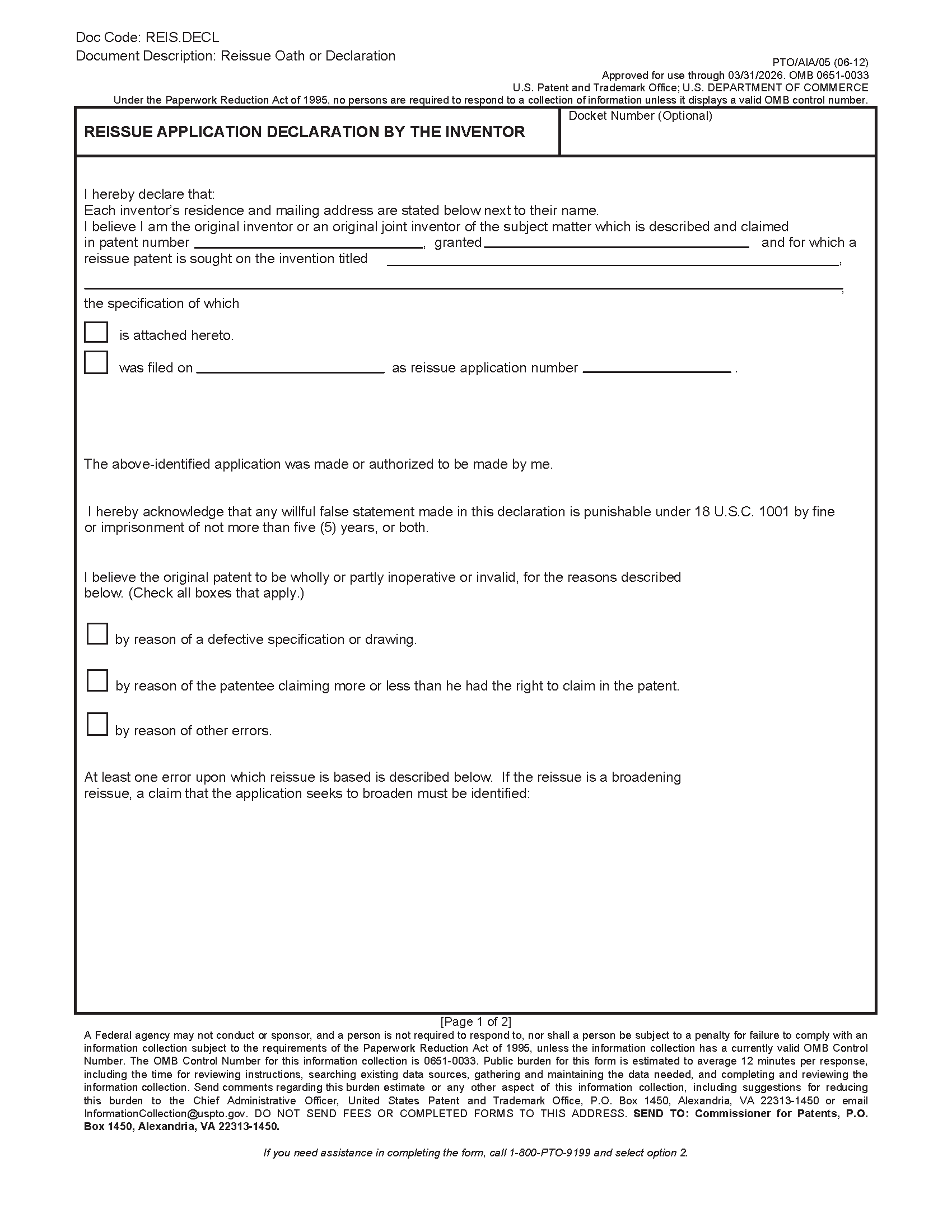

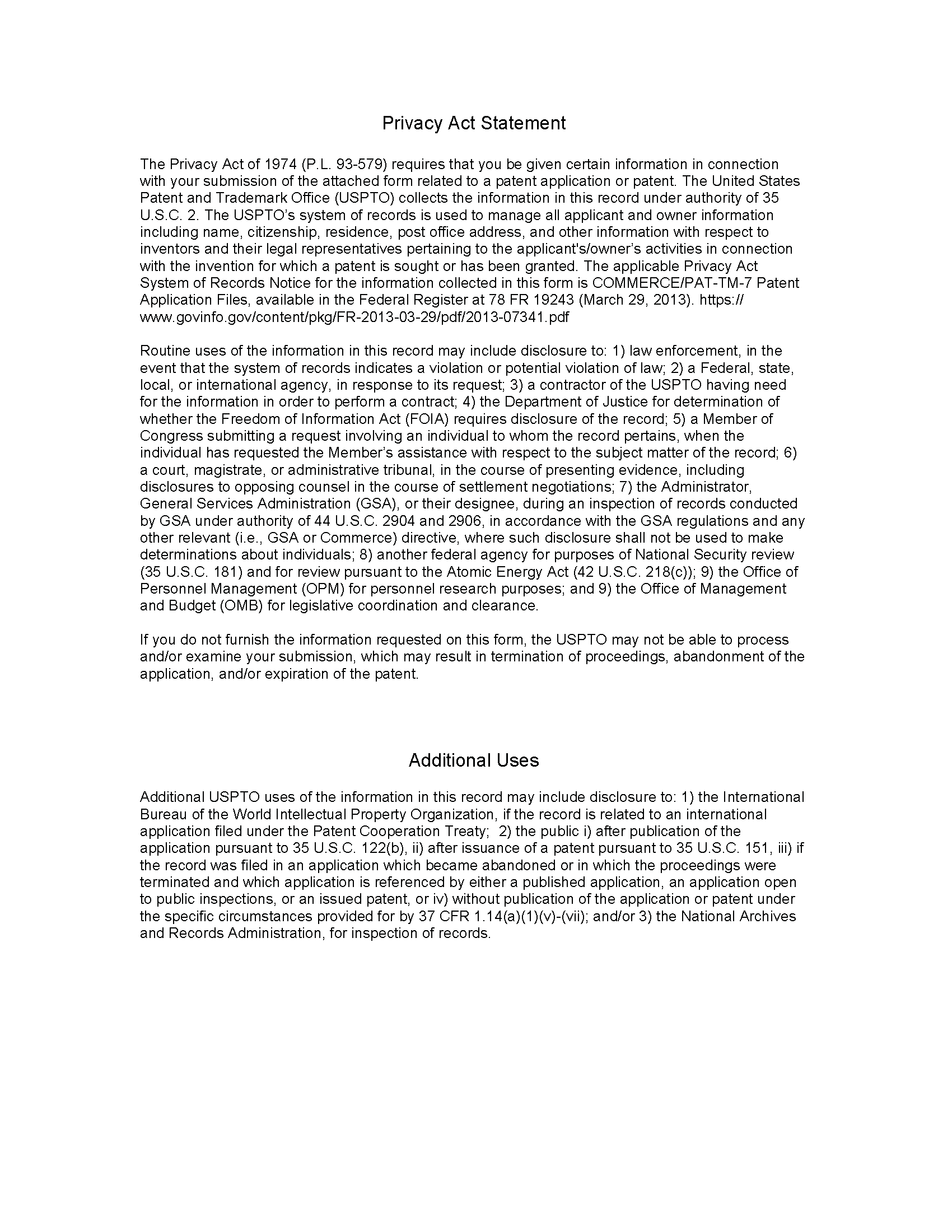

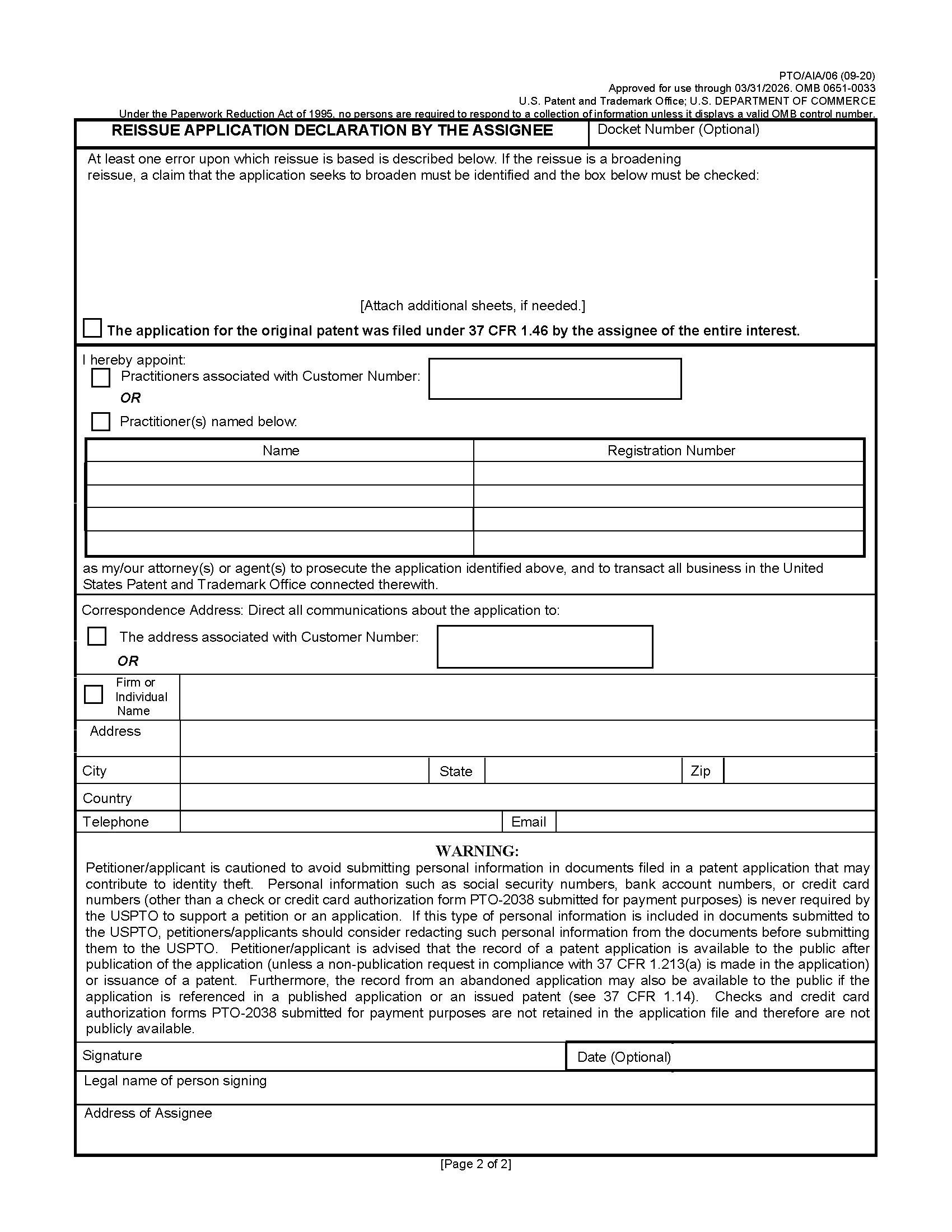
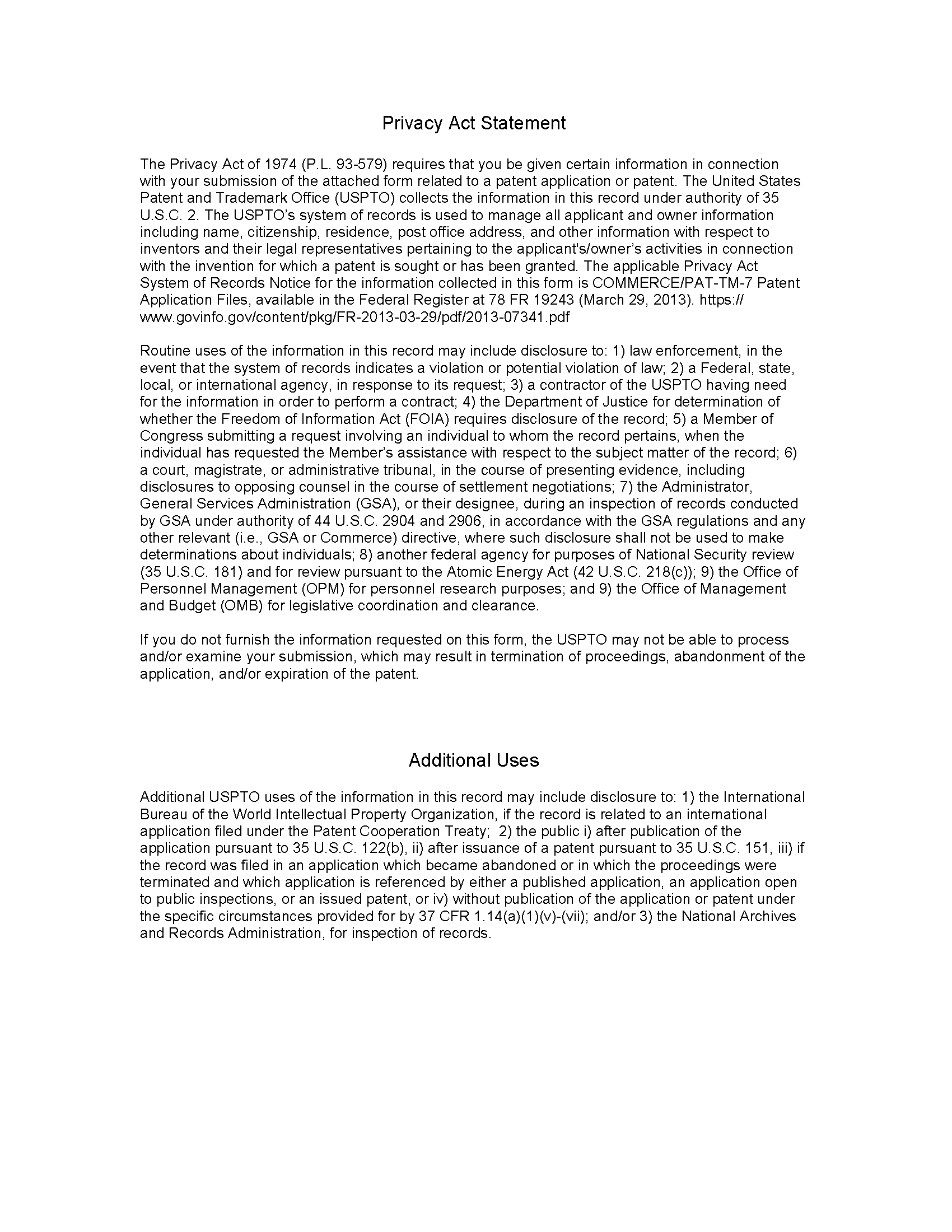

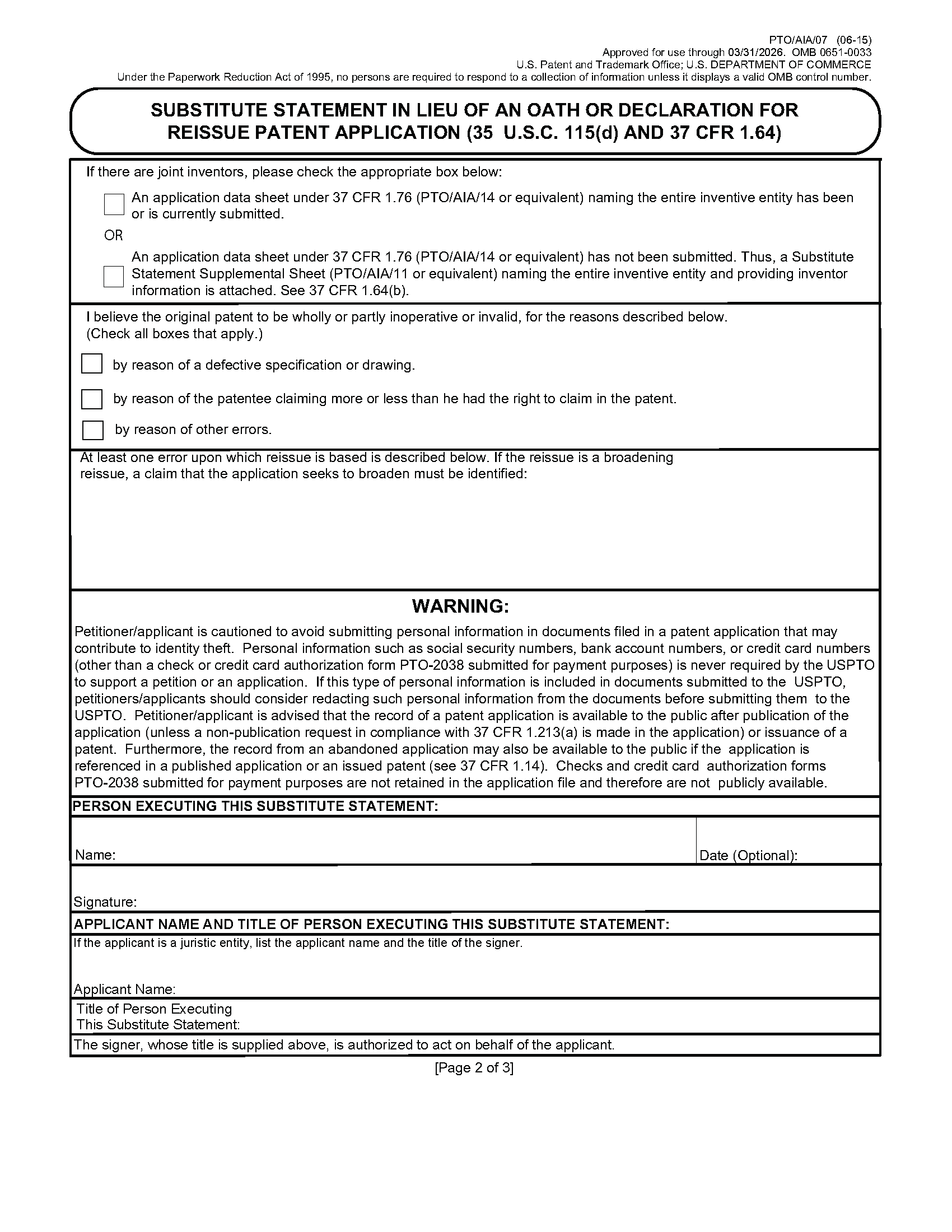
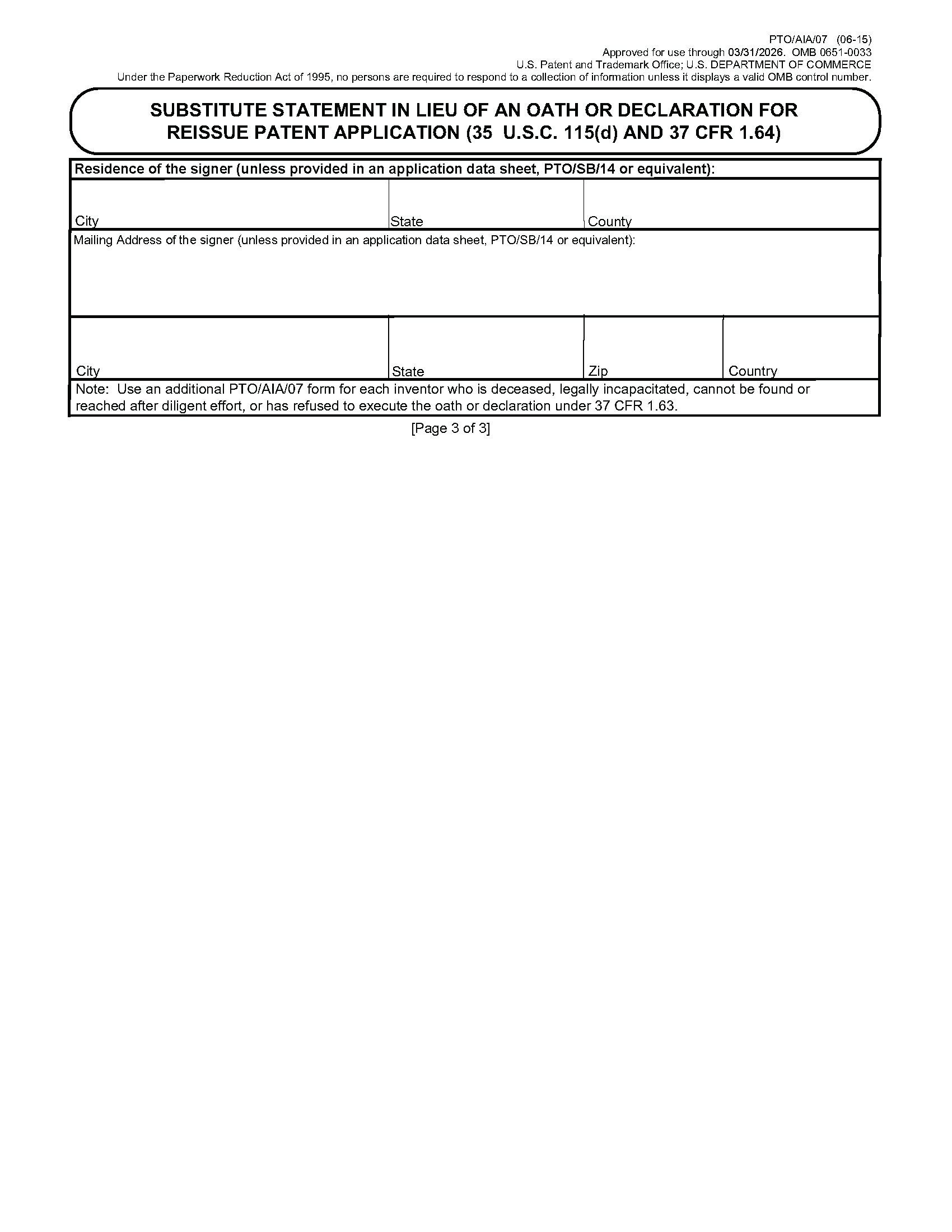
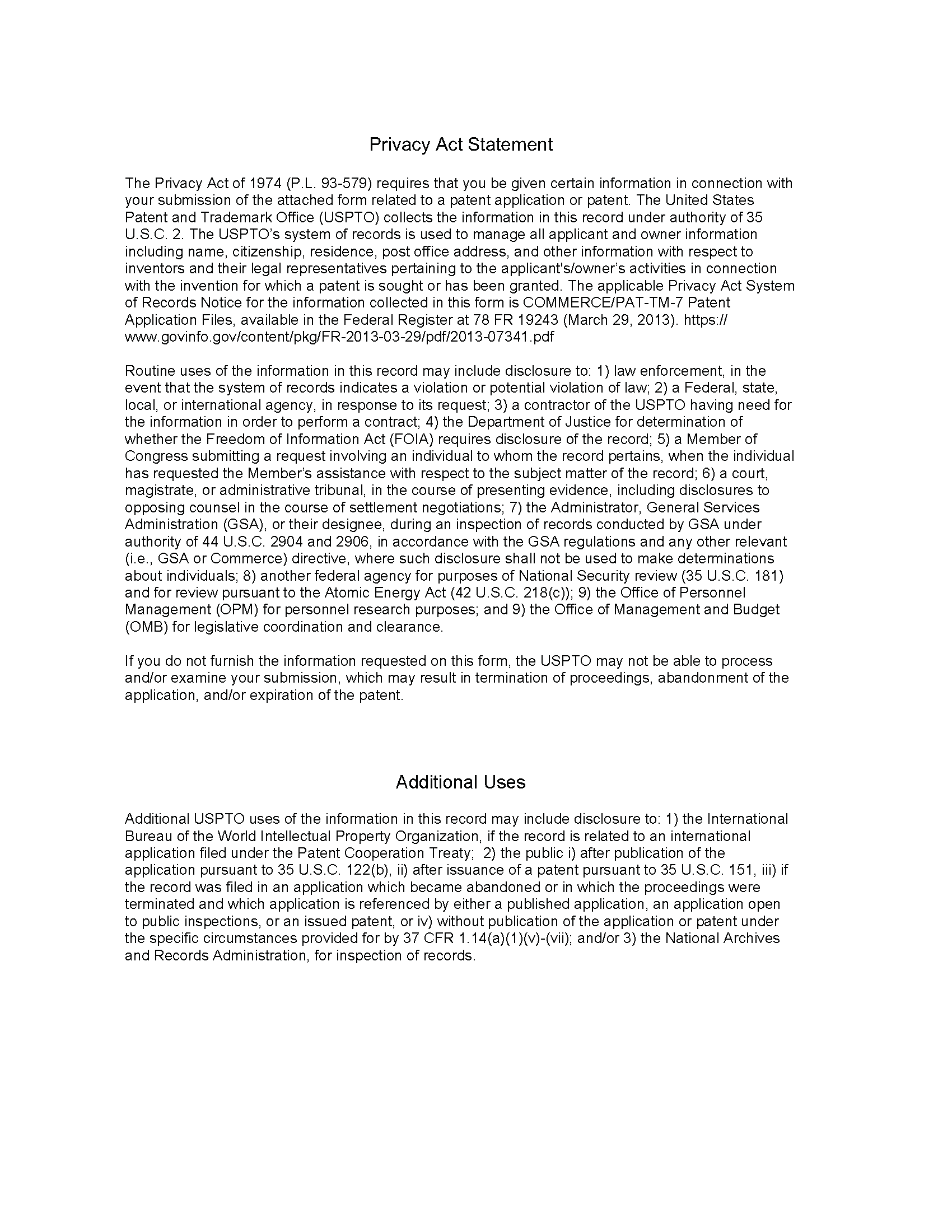
1414.02 Reissue Oath or Declaration in Reissue Application Filed Before September 16, 2012 [R-01.2024]
[Editor Note: See MPEP § 1414.01 for reissue applications filed on or after September 16, 2012.]
Pre-AIA 37 CFR 1.175 Reissue oath or declaration.
- (a) The reissue oath or declaration in addition to
complying with the requirements of § 1.63, must also state
that:
- (1) The applicant believes the original patent to be wholly or partly inoperative or invalid by reason of a defective specification or drawing, or by reason of the patentee claiming more or less than the patentee had the right to claim in the patent, stating at least one error being relied upon as the basis for reissue; and
- (2) All errors being corrected in the reissue application up to the time of filing of the oath or declaration under this paragraph arose without any deceptive intention on the part of the applicant.
- (b)
- (1) For any error corrected, which is not
covered by the oath or declaration submitted under paragraph (a) of this
section, applicant must submit a supplemental oath or declaration stating
that every such error arose without any deceptive intention on the part
of the applicant. Any supplemental oath or declaration required by this
paragraph must be submitted before allowance and may be submitted:
- (i) With any amendment prior to allowance; or
- (ii) In order to overcome a rejection under 35 U.S.C. 251 made by the examiner where it is indicated that the submission of a supplemental oath or declaration as required by this paragraph will overcome the rejection.
- (2) For any error sought to be corrected after allowance, a supplemental oath or declaration must accompany the requested correction stating that the error(s) to be corrected arose without any deceptive intention on the part of the applicant.
- (1) For any error corrected, which is not
covered by the oath or declaration submitted under paragraph (a) of this
section, applicant must submit a supplemental oath or declaration stating
that every such error arose without any deceptive intention on the part
of the applicant. Any supplemental oath or declaration required by this
paragraph must be submitted before allowance and may be submitted:
- (c) Having once stated an error upon which the reissue is based, as set forth in paragraph (a)(1), unless all errors previously stated in the oath or declaration are no longer being corrected, a subsequent oath or declaration under paragraph (b) of this section need not specifically identify any other error or errors being corrected.
- (d) The oath or declaration required by paragraph (a) of this section may be submitted under the provisions of § 1.53(f).
- (e) The filing of any continuing reissue application which does not replace its parent reissue application must include an oath or declaration which, pursuant to paragraph (a)(1) of this section, identifies at least one error in the original patent which has not been corrected by the parent reissue application or an earlier reissue application. All other requirements relating to oaths or declarations must also be met.
A statement in the reissue oath or declaration that all errors being corrected in the reissue application arose without any deceptive intention on the part of the applicant is required for a reissue application filed before September 16, 2012. In order to satisfy this requirement, the following statement may be included:
"All errors corrected in the present reissue application up to the time of signing of this oath/declaration, or errors which are being corrected by a paper filed concurrently with this oath/declaration which correction of errors I/we have reviewed, arose without any deceptive intention on the part of the applicant."
Nothing more is required. The examiner will determine only whether the reissue oath/declaration contains the required averment; the examiner will not make any comment as to whether it appears that there was in fact deceptive intention (see MPEP § 2012). It is noted that a reissue oath/declaration will not be effective for any errors which are corrected by a filing made after the execution of the reissue oath/declaration, unless it is clear from the record that the parties executing the document were aware of the nature of the correction when they executed the document. Further, a reissue oath/declaration with an early date of execution cannot be filed after a correction made later in time, to cover the correction made after the execution date. This is so, even if the reissue oath/declaration states that all errors up to the filing of the oath/declaration arose without any deceptive intention on the part of the applicant.
Form paragraph 14.01.04.fti may be used where the reissue oath/declaration does not provide the required statement as to “without any deceptive intention on the part of the applicant.”
¶ 14.01.04.fti Defective Reissue Oath/Declaration in Application Filed Before Sept. 16, 2012, 37 CFR 1.175- Lack of Statement of “Without Any Deceptive Intention”
The reissue oath/declaration filed with this application, which has a filing date before September 16, 2012, is defective because it fails to contain a statement that all errors which are being corrected in the reissue application up to the time of filing of the oath/declaration arose without any deceptive intention on the part of the applicant. See pre-AIA 37 CFR 1.175 and MPEP § 1414.
Examiner Note:
- 1. For reissue applications filed before September 16, 2012, use this form paragraph when the reissue oath/declaration does not contain the statement required by pre-AIA 37 CFR 1.175 that all errors being corrected in the reissue application arose without any deceptive intention on the part of the applicant.
- 2. This form paragraph is appropriate to use for a failure by applicant to comply with the requirement, as to any of pre-AIA 37 CFR 1.175(a)(2), 37 CFR 1.175(b)(1), or 37 CFR 1.175(b)(2).
- 3. Form paragraph 14.14 must follow.
The Office of Patent Application Processing (OPAP) should review the reissue oath/declaration for compliance with pre-AIA 37 CFR 1.63; thus, the examiner is not required to do such review.
The reissue oath/declaration must include the averments required by pre-AIA 37 CFR 1.63(a) and (b), e.g., that applicants for reissue
(A) have reviewed and understand the contents of the specification, including the claims, as amended by any amendment specifically referred to in the oath/declaration;
(B) believe the named inventor or inventors to be the original and the first inventor or inventors of the subject matter which is claimed and for which a patent is sought; and
(C) acknowledge the duty to disclose to the Office all information known to the person to be material to patentability as defined in 37 CFR 1.56. See also the discussion regarding the requirements of an oath/declaration beginning at MPEP § 602.
See MPEP § 1414.03 for a discussion of the requirements for a supplemental reissue oath/declaration.
Depending on the circumstances, either form PTO/SB/51, Reissue Application Declaration By The Inventor, or form PTO/SB/52, Reissue Application Declaration By The Assignee, may be used to prepare a declaration in a reissue application.
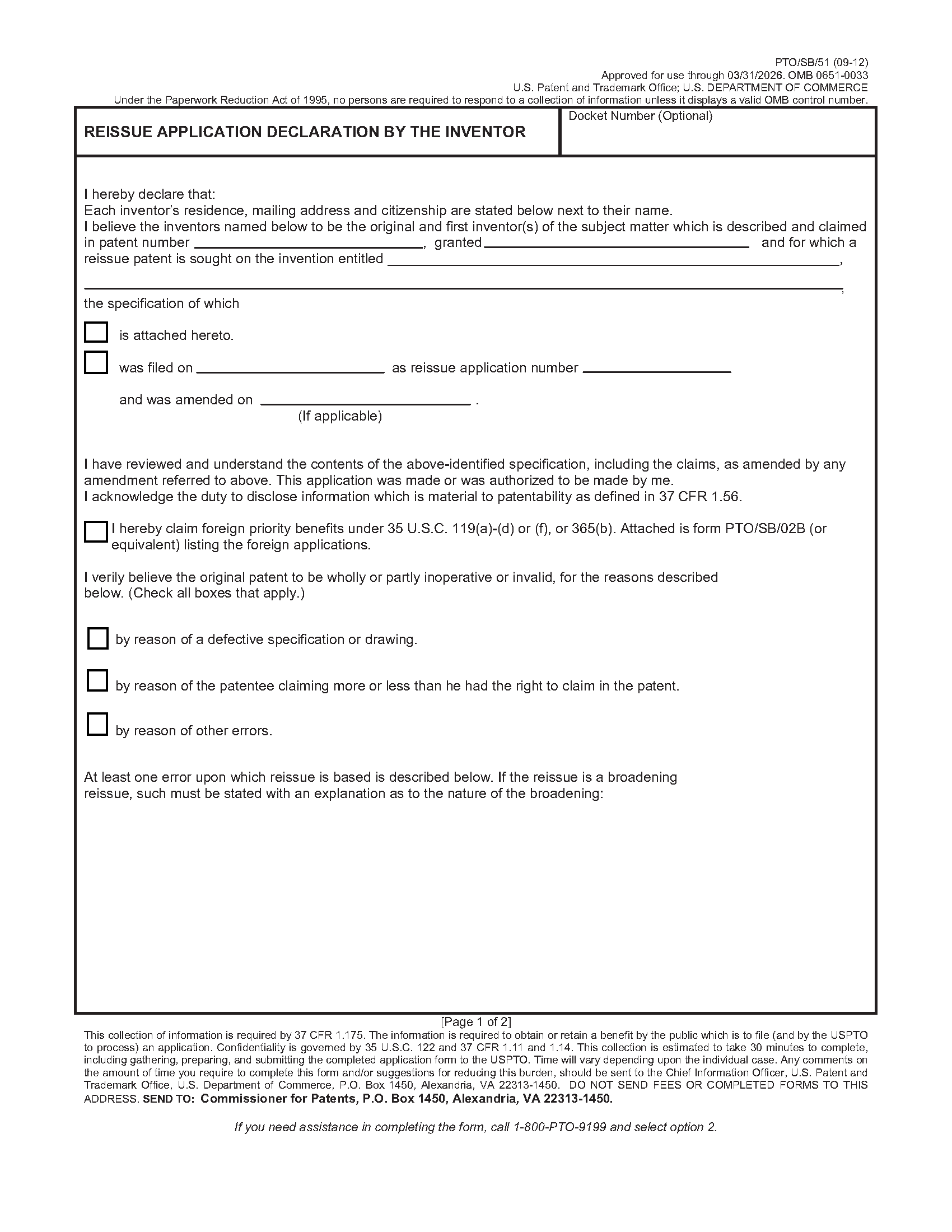
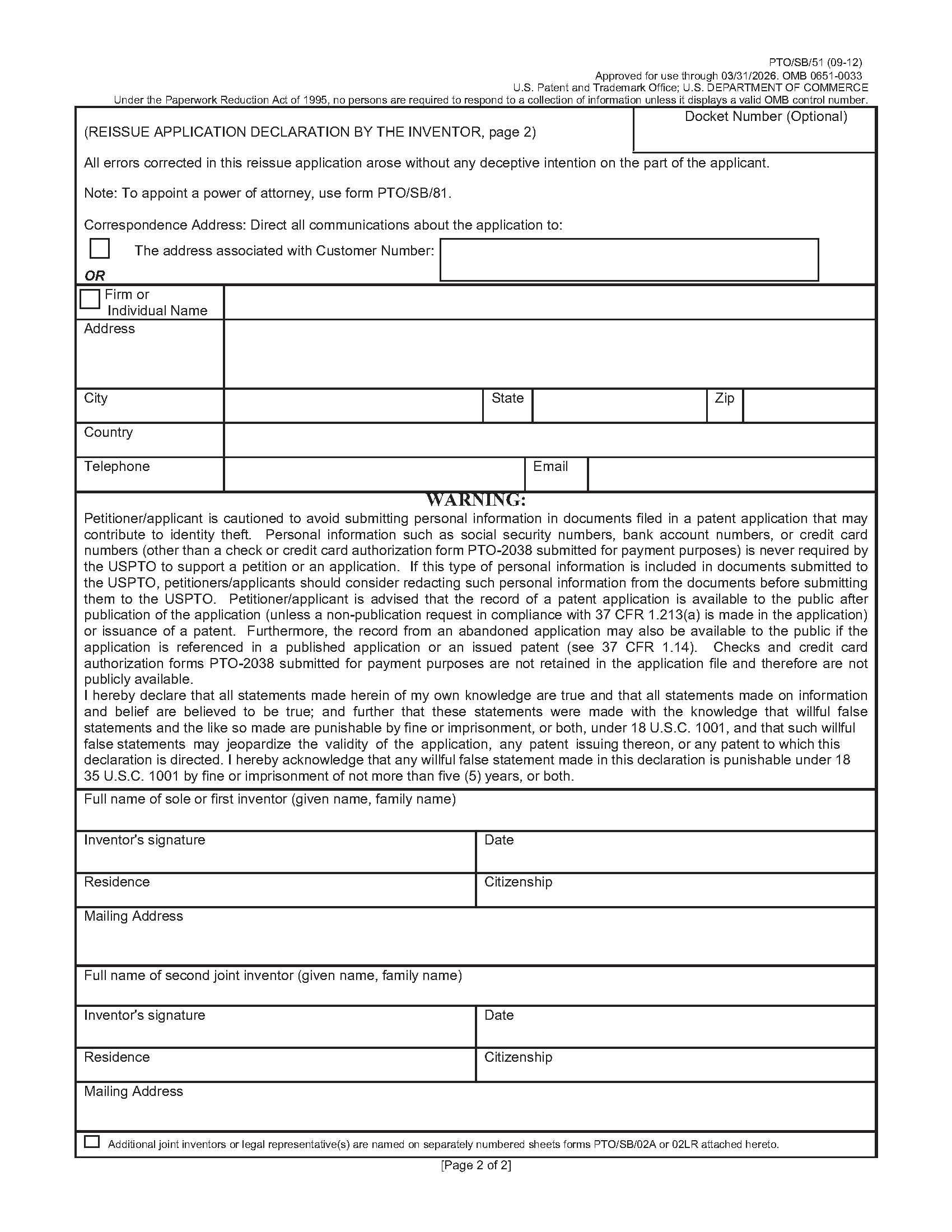
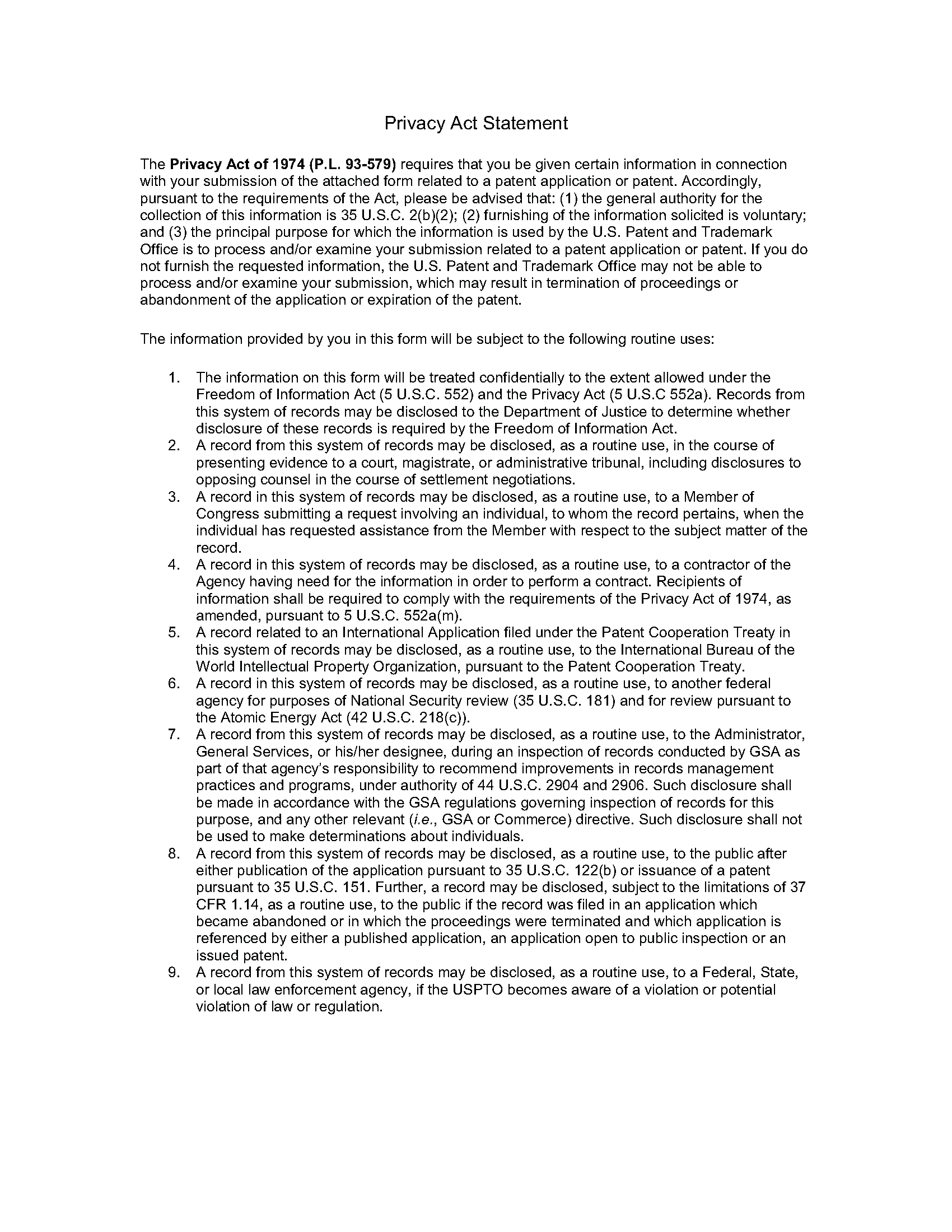
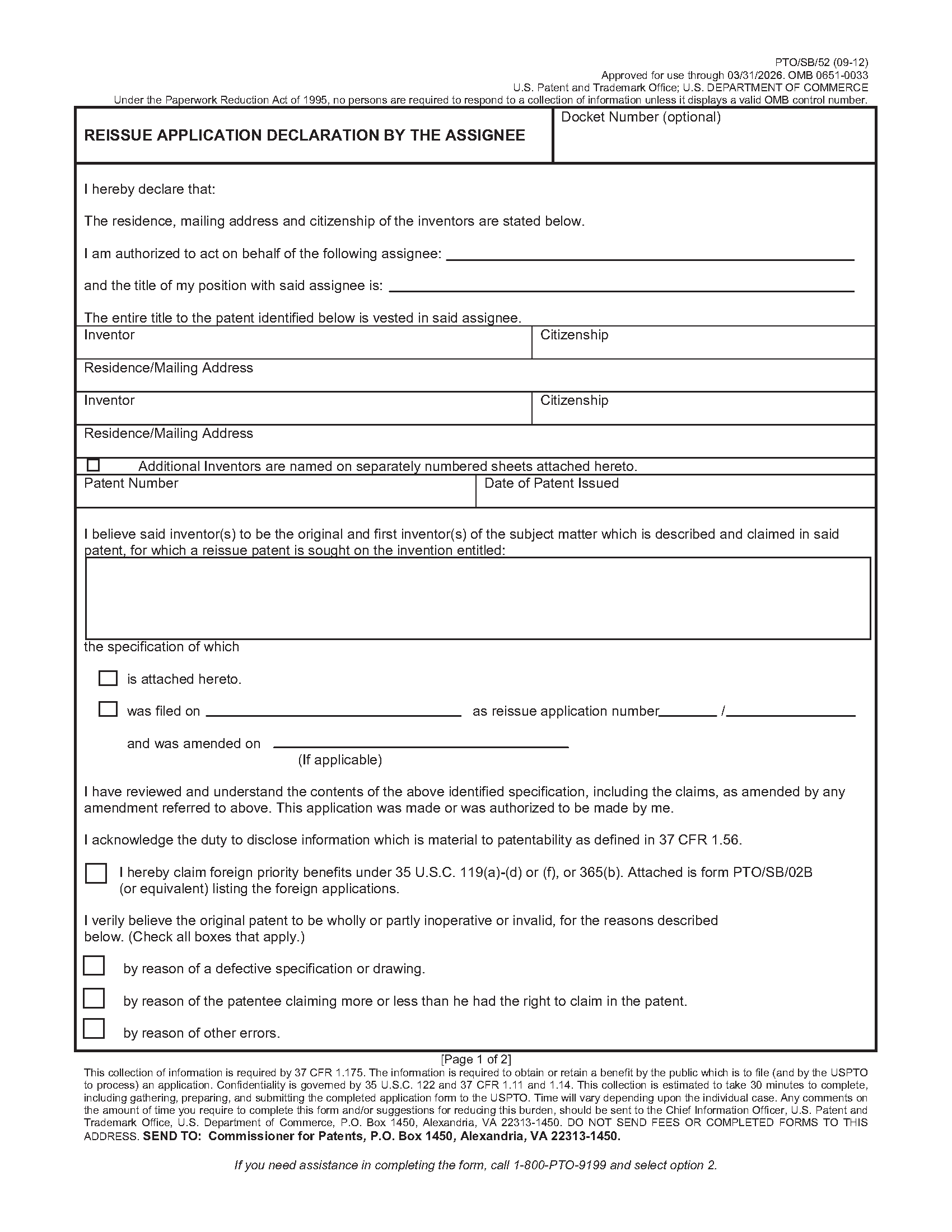
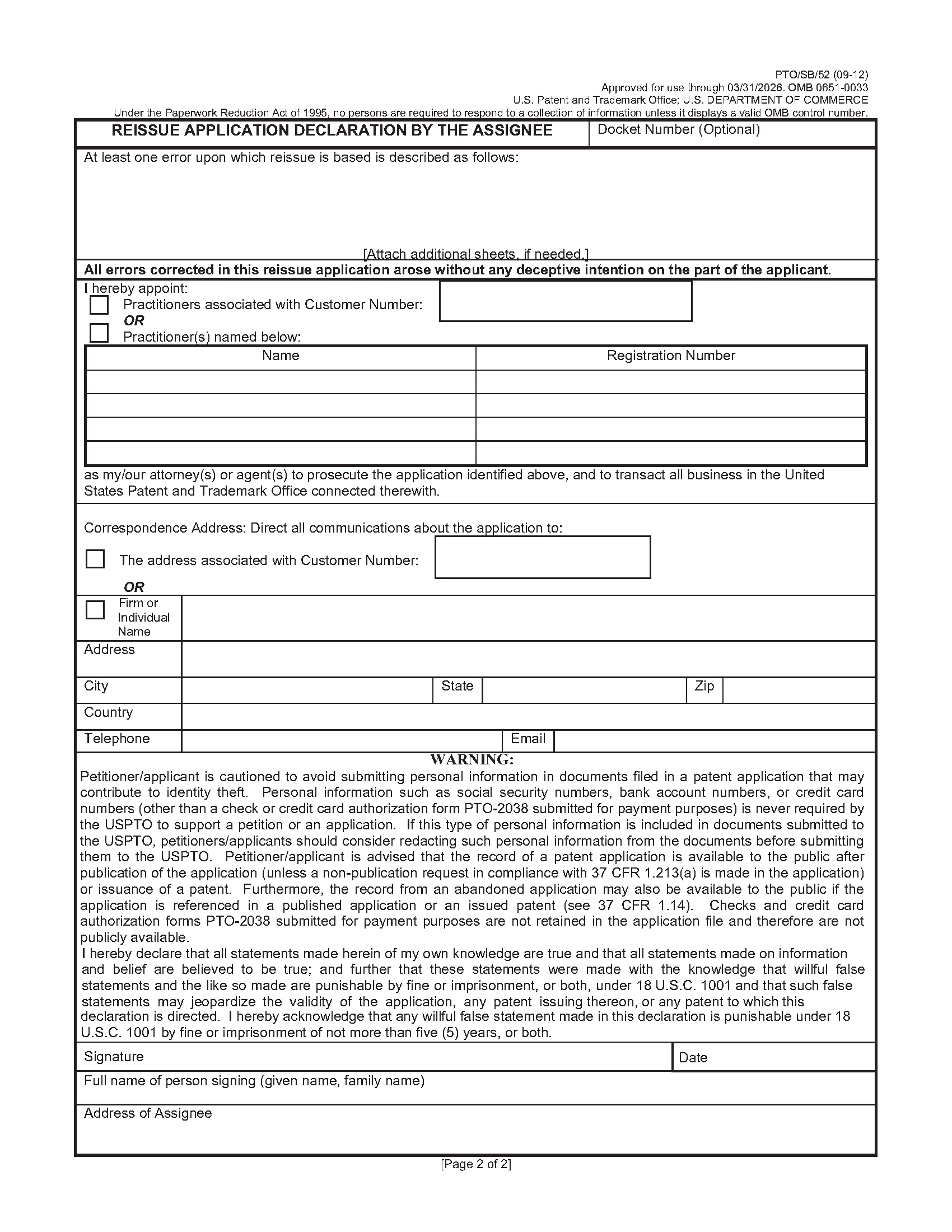
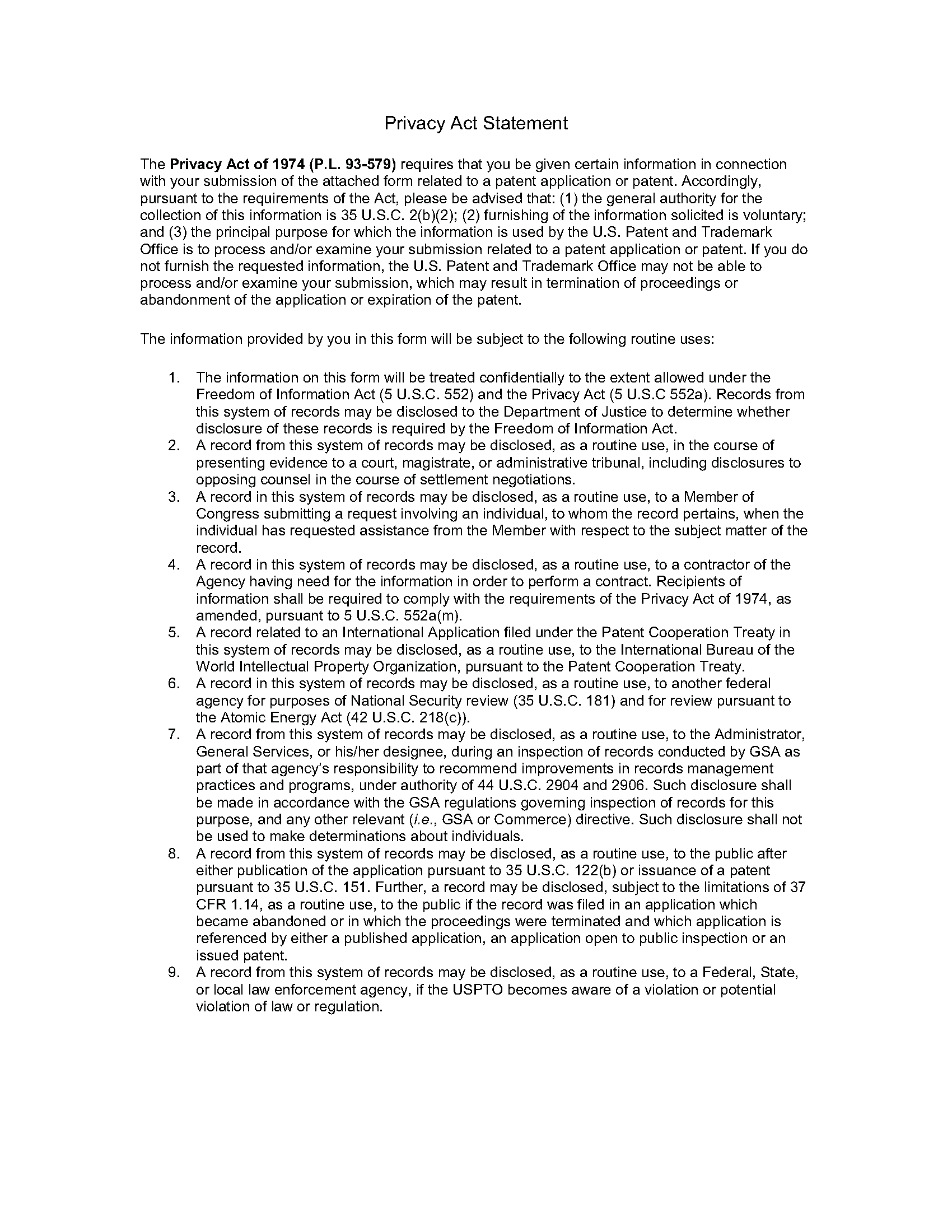
1414.03 Supplemental Reissue Oath/Declaration [R-08.2017]
I. REISSUE APPLICATION FILED ON OR AFTER SEPTEMBER 16, 2012[Editor Note: See subsection II, below, for reissue applications filed before September 16, 2012.]
Pursuant to 37 CFR 1.67(a), the applicant may submit an inventor's oath or declaration meeting the requirements of 37 CFR 1.63, 1.64, or 1.162 to correct any deficiencies or inaccuracies present in an earlier-filed inventor's oath or declaration.
For applications filed on or after September 16, 2012, if additional defects or errors are corrected in the reissue after the filing of the reissue oath or declaration, a supplemental reissue oath or declaration is not required. However, where all errors previously identified in the reissue oath/declaration are no longer being relied upon as the basis for reissue, the applicant must explicitly identify on the record an error being relied upon as the basis for reissue (e.g., in the remarks accompanying an amendment). See 37 CFR 1.175(d). Identification of the error must be conspicuous and clear, and must comply with 35 U.S.C. 251.
II. REISSUE APPLICATION FILED BEFORE SEPTEMBER 16, 2012[Editor Note: See subsection I, above, for reissue applications filed on or after September 16, 2012.]
For applications filed before September 16, 2012, if additional defects or errors are corrected in the reissue after the filing of the application and the original reissue oath or declaration, a supplemental reissue oath/declaration must be filed, unless all additional errors corrected are spelling, grammar, typographical, editorial or clerical errors which are not errors under pre-AIA 35 U.S.C. 251 (see MPEP § 1402). In other words, a supplemental oath/declaration is required where any “error” under pre-AIA 35 U.S.C. 251 has been previously corrected, or is being corrected at the time the supplemental reissue oath/declaration is submitted, and the error was not covered by a previously filed reissue oath/declaration.
The supplemental reissue oath/declaration must state that every error which was corrected in the reissue application not covered by the prior oath(s)/declaration(s) submitted in the application arose without any deceptive intention on the part of the applicant.
An example of acceptable language is as follows:
"Every error in the patent which was corrected in the present reissue application, and is not covered by the prior declaration submitted in this application, arose without any deceptive intention on the part of the applicant."
A supplemental reissue oath/declaration will not be effective for any errors which are corrected by a filing made after the execution of the supplemental reissue oath/declaration, unless it is clear from the record that the parties executing the document were aware of the nature of the correction when they executed the document. Further, a supplemental reissue oath/declaration with an early date of execution cannot be filed after a correction made later in time, to cover the correction made after the execution date. This is so, even if the supplemental reissue oath/declaration states that all errors up to the filing of the supplemental reissue oath/declaration oath or declaration arose without any deceptive intention on the part of the applicant.
Form PTO/SB/51S, “Supplemental Declaration For Reissue Patent Application To Correct ‘Errors’ Statement (37 CFR 1.175),” may be used to prepare a supplemental reissue declaration. Form PTO/SB/51S serves to indicate that every error in the patent that was corrected in the reissue application, but was not covered by a prior reissue oath/declaration submitted in the reissue application, arose without any deceptive intention on the part of the applicant.
In the event that the applicant for a reissue application is required to file a supplemental reissue oath/declaration that also includes a specific statement of the error being corrected by reissue in accordance with pre-AIA 37 CFR 1.175(c), as discussed in subsection A. below, applicant must also include in the supplemental declaration language equivalent to the “Every error …” language in the example of acceptable language set forth above. Therefore, if either form PTO/SB/51, “Reissue Application Declaration By The Inventor,” or form PTO/SB/52, “Declaration By The Assignee” (see MPEP § 1414) is used for the purpose of filing such supplemental reissue oath/declaration, the form must be completed so that it is clear that the supplemental reissue oath/declaration addresses all errors corrected subsequent to the date upon which the last previous reissue oath/declaration (whether original or supplemental) was filed. For example, the form could be completed by specifying the date upon which the reissue application was originally filed, the reissue application number, and the date(s) of every amendment filed subsequent to the date upon which the last reissue oath/declaration (whether original or supplemental) was filed. Any manner of completing the form so that affiant/declarant unambiguously states that every error corrected subsequent to the filing of the last filed reissue oath/declaration (whether original or supplemental) arose without deceptive intent will be acceptable. It will not be acceptable for a newly filed supplemental oath/declaration to simply refer to the reissue application as filed, even though the new oath/declaration may be submitted after an amendment.
A. When An Error Must Be Specifically Identified In The Supplemental Oath/DeclarationIn the supplemental reissue oath/declaration, there is no need to specifically identify any additional error which is relied upon to support the reissue application if:
- (A) an error to support a reissue has been previously and properly stated in a reissue oath/declaration in the publication; and
- (B) that error is still being corrected in the reissue application.
If applicant chooses to state any further error at this point (even though such is not needed), the examiner should not review the statement of the further error.
The supplemental reissue oath/declaration must specifically identify an error which is relied upon to support the reissue application only where one of the following is true:
- (A) the prior reissue oath/declaration failed to state an error;
- (B) the prior reissue oath/declaration attempted to state an error but did not do so properly; or
- (C) all errors under pre-AIA 35 U.S.C. 251 stated in the prior reissue oath(s)/declaration(s) are no longer being corrected in the reissue application.
The supplemental oath/declaration in accordance with pre-AIA 37 CFR 1.175(b)(1) must be submitted before allowance. See MPEP § 1444 for a discussion of the action to be taken by the examiner to obtain the supplemental oath/declaration in accordance with pre-AIA 37 CFR 1.175(b)(1), where such is needed.
Where applicant seeks to correct an error after allowance of the reissue application, a supplemental reissue oath/declaration must accompany the requested correction stating that the error(s) to be corrected arose without any deceptive intention on the part of the applicant. The supplemental reissue oath/declaration submitted after allowance will be directed to the error applicant seeks to correct after allowance. This supplemental oath/declaration need not cover any earlier errors, because all earlier errors should have been covered by a reissue oath/declaration submitted before allowance.
C. Supplemental Oath/Declaration In Broadening ReissueA broadening reissue application must be applied for by all of the inventors (patentees), that is, the original reissue oath/declaration must be signed by all of the inventors. See MPEP § 1414. If a supplemental oath/declaration in a broadening reissue application is subsequently needed in the application in order to fulfill the requirements of pre-AIA 37 CFR 1.175, the supplemental reissue oath/declaration must be signed by all of the inventors. In re Hayes, 53 USPQ2d 1222, 1224 (Comm’r Pat. 1999) (“37 CFR 1.175(b)(1), taken in conjunction with Section 1.172, requires a supplemental declaration be signed by all of the inventors. This is because all oaths or declarations necessary to fulfill the rule requirements in a reissue application are taken together collectively as a single oath or declaration. Thus, each oath and declaration must bear the appropriate signatures of all the inventors.”).
If a joint inventor refuses or cannot be found or reached to sign a supplemental oath/declaration, a supplemental oath/declaration listing all the inventors, and signed by all the available inventors may be filed provided it is accompanied by a petition under 37 CFR 1.183, along with the petition fee, requesting waiver of the signature requirement of the nonsigning inventor.
If a sole inventor refuses or cannot be found or reached to sign a supplemental oath/declaration, a supplemental oath/declaration listing the sole inventor, and signed by the assignee or a party who otherwise shows sufficient proprietary interest in the matter justifying such action may be filed provided it is accompanied by a grantable petition under 37 CFR 1.183, along with the petition fee, requesting waiver of the signature requirement of the nonsigning inventor.

